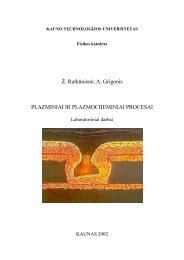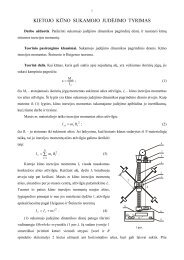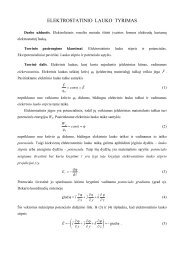PROCEEDINGS OF THE 7 INTERNATIONAL ... - Fizika
PROCEEDINGS OF THE 7 INTERNATIONAL ... - Fizika
PROCEEDINGS OF THE 7 INTERNATIONAL ... - Fizika
Create successful ePaper yourself
Turn your PDF publications into a flip-book with our unique Google optimized e-Paper software.
E<br />
D<br />
A<br />
B<br />
C<br />
V. Poderys et al. / Medical Physics in the Baltic States 7 (2009) 24 - 29<br />
Fig. 4 AFM images of CdTe quantum dots (A-D) and CdTe<br />
quantum dots with BSA on mica. CdTe quantum dots<br />
deposited from solution in deionized water: A – 40 minutes<br />
after preparation, B – 5 hours after preparation, C – 24 hours<br />
after preparation. D – CdTe quantum dots deposited from<br />
saline solution after precipitate was formed (insert – phase<br />
image). E – CdTe quantum dots with BSA deposited from<br />
saline solution 1 month after preparation of solution. (A–C<br />
and E images are 2 μm x 2 μm, image D – 5 μm x 5 μm).<br />
We also measured photoluminescence kinetics of<br />
quantum dots solution in deionized water with and<br />
without BSA. Photoluminescence decay of both<br />
samples is presented in Fig. 5. Photoluminescence of<br />
quantum dots without protein decays faster (Fig.5 line<br />
A) and four photoluminescence decay lifetimes are<br />
needed to get good decay fit (reduced χ 2 =1.018). These<br />
lifetimes are: τ1=3.4ns, τ2=14.1ns, τ3=30 ns, τ4=88,2 ns.<br />
Fitting with tree exponents doesn’t give good results –<br />
χ 2 =1.268. In case of quantum dots solutions with BSA,<br />
three exponents are enough to get good fitting results<br />
(χ 2 =1.063, life times - τ1=10.5ns, τ2=29.6ns,<br />
τ3=78.9ns).<br />
28<br />
A<br />
Fig. 5. Photoluminescence decay kinetics of CdTe quantum<br />
dots in deionized water (measured 48 h after preparation): line<br />
A – without BSA, line B – with BSA.<br />
4. Discussion<br />
Dynamics of absorption and photoluminescence<br />
properties of investigated solutions (presented in Fig. 1<br />
and Fig. 3) shows two phases – growth of<br />
photoluminescence and decrease of photoluminescence.<br />
In the first phase photoluminescence of quantum dots<br />
increased in all investigated solutions. Despite quite large<br />
increase in photoluminescence spectra, changes in<br />
absorption spectrum are very small an even a small<br />
decrease of absorption band can be seen after 24 hours.<br />
After that absorption of quantum dots solutions starts<br />
slowly increasing. During this phase photoluminescence<br />
band peak position and width remain constant. These<br />
changes indicate that core of quantum dot remains intact.<br />
Core degradation would cause blue shift of<br />
photoluminescence band; aggregation of quantum dots<br />
would cause a red shift. Change of photoluminescence<br />
intensity indicates, that properties of quantum dots<br />
coating (or coating itself) is changing: molecules coating<br />
core of quantum dot are rearranging, being replaced by<br />
other molecules of being washed-out. Theoretically<br />
increase of quantum dots photoluminescence intensity is<br />
explained by decrease of nonradiative transitions or their<br />
speeds. Decrease of defects on quantum dots surface<br />
would give this effect [11]. Another process that can<br />
change intensity of quantum dots photoluminescence is<br />
aggregation. Aggregation of quantum dots decreases<br />
photoluminescence quantum yield. Slow dissolution<br />
(monomerisation) of quantum dots powder (aggregates)<br />
could cause increasing photoluminescence intensity due<br />
to increased photoluminescence quantum yield of<br />
monomeric quantum dots compared with aggregated<br />
form. More detail investigation of absorption spectrum<br />
dynamics during first two days after preparation of<br />
solution (Fig. 1 B insert) contradicts to this explanation.<br />
Absorption of quantum dots dissolved in deionized water<br />
decreases during first day. This decrease can be<br />
explained by aggregation of quantum dots. Aggregation<br />
of quantum dots leads to decrease of absorption intensity,<br />
red shift, broadening and intensity decrease of<br />
photoluminescence band. But in first phase width and<br />
wavelength of photoluminescence band doesn’t change,<br />
photoluminescence intensity increases. So these changes<br />
are caused not by aggregation of quantum dots but by<br />
changes in quantum dot coating. CdTe-TGA quantum<br />
dots are fluorescent nanoparticles composed of CdTe<br />
core and TGA coating. Rearrangement of quantum dot<br />
B








